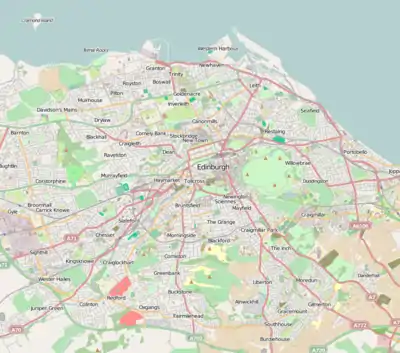| Canongate Tolbooth | |
|---|---|
 Canongate Tolbooth | |
| Location | Old Town, Edinburgh |
| Coordinates | 55°57′05″N 3°10′48″W / 55.9515°N 3.1800°W |
| Built | 1591 |
| Architectural style(s) | Scottish medieval style |
Listed Building – Category A | |
| Official name | 163 Canongate, Canongate Tolbooth |
| Designated | 14 December 1970 |
| Reference no. | LB27582 |
 Shown in Edinburgh | |
Canongate Tolbooth is a historic landmark of the Old Town area of Edinburgh, built in 1591 as a tolbooth, that is, the centre of administration and justice of the then separate burgh of the Canongate which was outside the Edinburgh town walls.[1] It ceased to be a municipal building in 1856 and it is now occupied by The People's Story Museum and is protected as a category A listed building.[2]
History

The tower of the tolbooth was built in 1591, and the block to the east of it at that time or slightly after, by Sir Lewis Bellenden, baron of Broughton and feudal superior of the burgh of Canongate and Lord Justice Clerk of Scotland.[2][3] It served as the courthouse, burgh jail and meeting place of the town council.[2]
Many Covenanters were held in the tolbooth in poor conditions in the 17th century[4][5] and a riot took place in the building in May 1692.[6] It ceased to be the meeting place of the burgh council when Canongate was annexed by Edinburgh in 1856.[7]
In 1875 the City Architect, Robert Morham, extensively restored and remodelled the exterior. Internally the first and attic floors were combined to make a single floor, now The People's Story Museum.[8][9]
Design
The tolbooth was designed in the Scottish medieval style: it comprises a bell tower with a lower block to the east that contained the council chamber and courtroom.[10] The tower has two bartizans with ornamental gunloops on either side of a clock, dated 1884 and manufactured by James Ritchie & Son, which is suspended over the Royal Mile by wrought iron brackets.[1][3][8] Above the bartizans is a conical spire[8] while at street level there is a round-arched pend that leads into Tolbooth Wynd.[11] Architectural features of the east block include a stone forestair which leads to a door next to the tower,[10] an oriel window,[3] and four pedimented dormers by Morham, based on Gordon of Rothiemay's map of 1647, that replaced three piended ones.[12]
To the east of the tolbooth, down the Royal Mile, is the Kirk of the Canongate and the Canongate Kirkyard.[11]
References
- 1 2 Historic Environment Scotland. "Edinburgh, 163 Canongate, Canongate Tolbooth, City Museum (52527)". Canmore. Retrieved 30 August 2021.
- 1 2 3 Historic Environment Scotland. "163 Canongate, Canongate Tolbooth (Category A Listed Building) (LB27582)". Retrieved 28 March 2019.
- 1 2 3 Youngson, A. J. (2001). The Companion Guide to Edinburgh and the Borders. Companion Guides. p. 54. ISBN 978-1-900639-38-5.
- ↑ "Canongate Tolbooth". Edinburgh World Heritage. Retrieved 4 December 2021.
- ↑ Dobson, David (2001). Directory of Scots Banished to the American Plantations, 1650-1775. Clearfield Company. p. 17. ISBN 978-0806310350.
- ↑ "Tolbooths". The Reformation. Retrieved 4 December 2021.
- ↑ Varga, Susan (2006). Edinburgh Old Town. The History Press. ISBN 978-0752440835.
- 1 2 3 Gifford, John; McWilliam, Colin; Walker, David (1984). Edinburgh. Yale University Press. p. 175. ISBN 978-0-300-09672-9.
- ↑ "Canongate Tolbooth". Gazetteer for Scotland. Retrieved 1 September 2014.
- 1 2 "Edinburgh, 163 Canongate, Canongate Tolbooth, City Museum". ScotlandsPlaces. Retrieved 1 September 2014.
- 1 2 Guide to Edinburgh and its neighbourhood. Oliver and Boyd. 1860. Retrieved 27 June 2017.
- ↑ Gordon of Rothiemay, James. "Bird's eye view of Edinburgh in 1647". National Library of Scotland. Retrieved 22 May 2021.